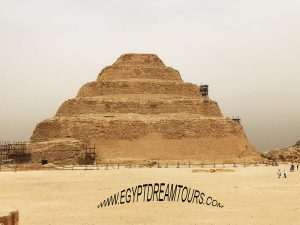Father of Architecture (Imhotep) 2600 BC
Imhotep: The Egyptian Polymath and Divine Genius Father of Architecture.

Imhotep (2655-2600 BC) was a polymath who left an indelible mark on ancient Egypt and changed architecture methods of his era.
He was revered as the first architect, engineer, and physician in recorded history, and his contributions to these fields were nothing short of astounding.
Imhotep was also a philosopher, and his ideas and teachings have inspired generations of thinkers.
Imhotep was a man of many talents, and his incredible intellect and skills allowed him to leave an impact in a variety of fields.
He designed the Step Pyramid of Djoser, considered to be the first pyramid ever built in Egypt, and his architectural innovations continue to influence modern building techniques.
As an engineer, he oversaw many important construction projects, including the building of canals and the creation of irrigation systems.
But Imhotep’s genius was not limited to architecture and engineering. He was also a skilled physician, credited with developing medical treatments for various ailments and injuries. Imhotep’s knowledge of medicine was so advanced that he was often considered a divine healer.
Imhotep’s contributions to ancient Egypt were so significant that he was revered as a divine figure after his death. He was one of only a few commoners ever to be acknowledged by the Egyptian people as having divine status, a testament to the impact he had on their culture and society.
Imhotep was not only a mastermind but also a philosopher who understood the importance of self-knowledge. He once said, “If you don’t have knowledge of self, you will end up living the illusions that others have created for you.” This quote reflects his wisdom and his understanding of the human condition.
No doubt that , Imhotep was a true genius who left a lasting legacy in ancient Egypt. He was a polymath who excelled in multiple fields, including architecture, engineering, and medicine. Imhotep’s contributions to these fields were so significant that he was revered as a divine figure by the Egyptian people. His philosophy and teachings continue to inspire us today, and his legacy is a testament to the power of human ingenuity and creativity.
What is a Step Pyramid?
The Step Pyramid is made up of a stack of rectangular mounds, each built of limestone blocks, and decreasing in size upward. That may seem odd to those of us who think “pyramid-shaped” means smooth-sided, no doubt because of the classic Giza Plateau pyramids, also dated to the Old Kingdom. But stepped pyramids were the common type of tomb for both private and public individuals until the 4th dynasty when Sneferu built the first smooth-sided bent pyramid. Roth (1993) has an interesting paper about what the shift from rectangular to pointy pyramids meant to Egyptian society and its relationship to the sun god Ra, but that’s a digression.

The very first pharaonic burial monuments were low rectangular mounds called mastabas, reaching a maximum height of 2.5 meters or about eight feet. Those would have been almost completely invisible from a distance, and, over time the tombs were built ever-increasingly larger. Djoser’s was the first truly monumental structure.
Djoser’s Pyramid Complex
Djoser’s Step Pyramid is at the heart of a complex of structures, enclosed by a rectangular stone wall. The buildings in the complex include a line of shrines, some fake buildings (and a few functional ones), high niched walls, and several ‘wsht‘ (or jubilee) courtyards. The largest wsht-courtyards are the Great Court south of the pyramid, and the Heb Sed courtyard between the rows of provincial shrines. The step pyramid is near the center, complemented by the south tomb. The complex includes subterranean storage chambers, galleries, and corridors, most of which were not discovered until the 19th century (although they were apparently excavated by Middle Kingdom pharaohs, see below)
One corridor that runs beneath the pyramid is decorated with six limestone panels depicting King Djoser. In these panels, Djoser is dressed in different ritual clothing and posed as standing or running. That has been interpreted to mean he is performing rituals associated with the sed festival (Friedman and Friedman). Sed rituals were dedicated to the jackal god known as Sed or Wepwawet, meaning Opener of the Ways, and an early version of Anubis. Sed can be found standing next to Egyptian dynastic kings right from the first images such as that on the Narmer Palette. Historians tell us that Sed festivals were rituals of physical renewal, in which the aged king would prove he still had the right of kingship by running a lap or two around the walls of the royal residence.


